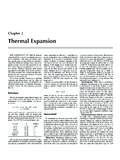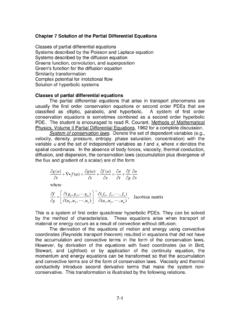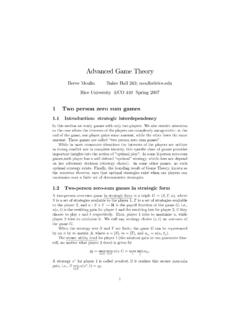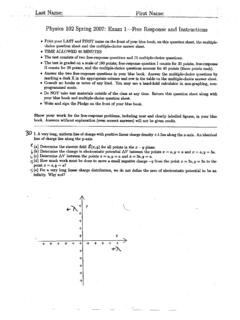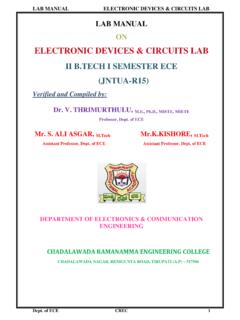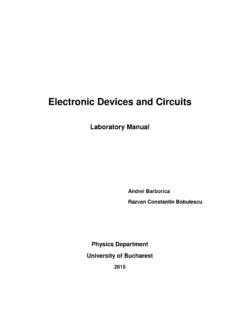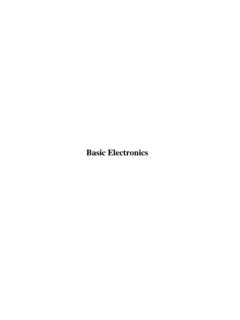Transcription of Notes on Analog Circuits - Rice University
1 1 PHYS 331: Junior Physics Laboratory INotes on Analog CircuitsDigital Circuits deal, in principle, with only two values of voltage, whereas Analog circuitsprocess signals with continuous variation of voltage. In fact, of course, no macroscopic signal istruly quantized, so even a digital circuit designer needs some familiarity with Analog Notes will provide a very basic introduction to the capabilities of Analog circuitry. Youmay also need to review the elementary analysis of passive DC and AC Circuits as found in afreshman physics Transistor actionTransistors of various types are essential to most modern electronics. They, in turn,depend upon the ability to fabricate semiconducting materials to very precise specifications. Webegin, therefore, by discussing very crudely how bipolar transistors function. Descriptions ofother types of transistors and more quantitative treatments can be found in the , as the name implies, are not insulators but neither do they conduct aswell as metals.
2 (Commercially important semiconductors include the elements silicon andgermanium, and compounds gallium arsenide and gallium phosphide.) The reason for this isquite simple: there are relatively few mobile charge carriers in a pure semiconductor at roomtemperature, and none at absolute zero. Semiconductors are technically useful because thedensity of charge carriers, and hence the conductivity, is exquisitely sensitive to part-per-millionlevels of impurities, referred to as "dopants". Furthermore, by appropriate choice of the dopant,either positive or negative charge carriers can be introduced. A specimen with predominantlypositive charge carriers is referred to as "p-type", while a specimen with negative carriers is "n-type". (The negative carriers are electrons, as in metals. The positive carriers are "holes", emptystates in an otherwise filled sea of electrons. The existence of holes with an effective positivecharge is a consequence of the Pauli exclusion principle acting in a crystalline lattice.)
3 Acomplete explanation can be found in any solid state physics text.)A piece of p-type material in intimate electrical contact with a piece of n-type materialforms a "pn junction" in the region of contact. If wires are attached to the sandwich, as indicatedin Fig. 1, it is found that the current-voltage characteristic is very asymmetric. The resultingdevice is called a "diode". For circuit use, two features of the diode I-V characteristic areimportant. First, there is a threshold (about in silicon) before significant current flows in the2forward direction. This threshold is the "junction voltage drop" or just "junction drop". For a"forward biased" diode above threshold the current increases very rapidly with little increase inapplied voltage. Second, there is a small "leakage current" when the diode is "reverse biased" (nside positive with respect to p side). This phenomenon is usually only a minor more interesting device can be made by joining three layers as shown in Fig.
4 2 tocreate an NPN bipolar transistor. (The term "bipolar" refers to the use of both n and p-typematerial in the structure. The following description also holds for the analogous PNP transistor ifall polarities are reversed. Other designs are possible, but will not be discussed here.) Evidentlythe base-emitter and base-collector Circuits will behave like diodes. The unexpected fact is that ifthe collector is made positive with respect to the emitter, then a current in the base-emitter circuitcan control the current flow across the (reverse biased) collector-base junction. For small basecurrents the relationship is linearIC=hFEIB= IB(1)where the current gain, hFE or , is typically 10-100. This current gain actually represents apower gain, in the sense that a low-power input signal applied to the base can cause a higher-power signal to appear in the collector nanode cathode+ V --100V -50V1V 2V20mA10mANote scale change!
5 2 A1 AFig. 1 Junction diode structure, circuit symbol and I-V = I + I EBBIC basecollectoremitterECBFig. 2 NPN junction transistor structure and circuit symbol3B. Gate circuitsAs a first example of transistor circuitry, consider Fig. 3, which shows the common-emitter configuration of an NPN transistor. The supply voltage VCC is taken to be positive. If Vinis zero or negative there will be no base current, hence no collector current, and the transistor issaid to be cut off. When Vin is positive and greater than the junction drop ( V for silicon), basecurrent will start to flow, the collector current will increase according to Eq. 1 and VCE willdecrease. For sufficiently large IB, VCE reaches a minimum ( V for silicon) and IC islimited chiefly by the load resistor R2. The transistor is now fully on, and is said to be ability to switch between two well defined states is ideal for implementing digital common-emitter configuration is itself a possible design for a NOT circuit .
6 Supposewe define logic 0 as a zero-volt signal and logic 1 as VCC, a positive voltage. Referring again toFig. 3, when Vin = 0 the transistor is cut off and Vout = VCC. Conversely, if we choose R1correctly the transistor can be driven to saturation when Vin = VCC. Vout is then nearly zero(actually VCE at saturation). More simply, Vout is the logical converse of Vin, as NOR circuit can be constructed using two transistors in common emitterconfigurations, as shown in Fig. 4. A logic high applied to either input (or both) turns on Q1 orQ2, pulling the output low, which is the required function. An OR circuit could be made bydriving the NOT circuit just described with the output of the TTL Circuits used for the digital exercises also employ transistors as switches,although the circuit configuration is somewhat different to facilitate manufacture. The designrules governing fan-out and logic levels are all determined by the circuit arrangements chosen toimplement the various logic = I + I EIBBICVinCCVRRVVCEBE21 VoutFig.
7 3 NPN transistor in common-emitter configuration4C. Single-stage amplifiersThe common emitter configuration can be modified to produce an output signal that islinearly proportional to the input, a function known as amplification. The trick is to supply aconstant base current, called a bias current, so that the transistor is partially turned on. The signalcurrent is then superimposed on the constant bias current. The resulting collector current willhave a DC component, proportional to the bias current, plus a varying component proportional tothe signal current. Figure 5 presents the same argument graphically, and Fig. 6 shows a circuitVCCVCCNORORABQQQ123 Fig. 4 Two-transistor NOR gate and conversion to Current, I ( A)BCollector Current, I (mA)CFig. 5 Plot of collector current vs base current showing effect of bias and signal inputs. Thedashed line indicates the bias current input and resulting collector current.
8 Addition of a varyingcomponent causes the collector current to follow within the limits Since the plot is not a straight line there will always be some distortion in theoutput signal, and signals large enough to drive the transistor into cut-off or saturation will belimited or 'clipped'.The output voltage of the common emitter amplifier can be substantially larger than theinput voltage. With no external signal, some amount of collector current flows, resulting in avoltage drop across the collector resistor which sets the output voltage between VCC and small positive signal input will cause additional base current to flow, which causes a muchlarger increase in the collector current, increasing the voltage drop across the collector resistorand lowering the output voltage. A small negative signal would decrease the base current,thereby increasing the output voltage. The output voltage is therefore an inverted and amplifiedreplica of the input, offset by a DC component due to the bias current.
9 The DC component can beblocked by another capacitor, leaving only the desired signal. A detailed analysis shows that thegain is determined by hFE and by the effective resistances at input and emitter resistor RE shown in Fig. 6 is not actually essential for circuit function, but itdoes serve a very useful purpose. The flow of collector current heats the junction because ofinevitable losses. The current gain hFE increases at higher temperatures, resulting in still morecollector current for the same bias current, further increasing the temperature. In the absence ofan emitter resistor, this succession of events can destroy the device, a phenomenon known asthermal runaway. At best, it will shift the operating point toward saturation and may make thecircuit inoperative. An emitter resistor reduces the tendency for thermal runaway by reducing theVCCinVoutVR1R2 RCRECFig. 6. Biased NPN common-emitter amplifier. A capacitor is used to couple in the AC signal sothat the signal source cannot affect the bias current.
10 The same circuit works for a PNP transistorif all polarities are from base to emitter as the collector current increases. The decrease in VBE decreases thebase current, partially compensating for the increased hFE and thereby stabilizing the circuit . Thisis an example of negative feedback, which we will see again later. Practically, an RE muchsmaller than RC is usually sufficient for one wants to transfer substantial power to a low resistance load. If the signalsource cannot supply the power, the emitter follower circuit in Fig. 7 is useful. A small currentfrom the signal source, applied to the base, can cause a large amount of current to flow throughthe emitter resistor or a load connected in parallel with it. Note that this amplifier does not invert:An increase in base voltage causes more collector current to flow, increasing the voltage at theemitter. It can be shown that the output voltage is only equal to the input voltage, minus the dropin the base-emitter diode, so there is no voltage gain.
